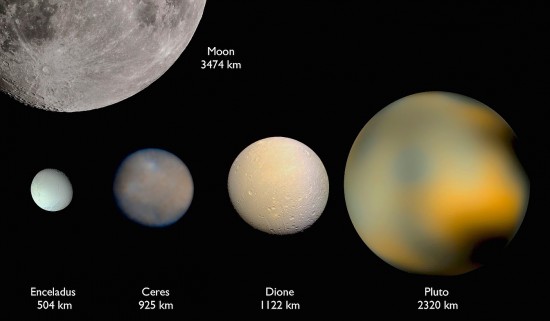May 1, 2015
Pluto is just ahead.
The Nebular Hypothesis suggests that the Solar System condensed out of a cloud of molecular gases and dust billions of years ago. Eventually, the dust and gas shrank to the point where compression started a nuclear chain reaction in the dense ball of hydrogen and helium at the center of the cloud, giving birth to a new star. As the material continued to be gravitationally attracted toward the center of the ever-shrinking mass, it formed a structure called an accretion disc circling its equatorial plane.
Similar to the rings of Saturn, only much more dense and far larger, the accretion disc extended out beyond the orbit of Neptune. According to scientists, during the collapse phase of the Solar System’s evolution, eddies and whirlpools of matter formed in the ring of dust and gas. Those eddies grew larger as they attracted more material into them, slowly sucking in larger and larger particles, then pebbles, then boulders, until hundreds of millions of impacts from nebular condensates gradually formed the planets.
The theory was later amended to include the Oort Cloud in order to explain the origin of the many comets that enter the Solar System every year. The Oort Cloud is supposed to be a giant nimbus of small fragments left over from those early days when the Sun was a newborn star. It is said to be a spherical region enclosing the Sun at a maximum radius of about 5 trillion kilometers and contains billions of objects, some as big as small planets, but most around the size of a medium asteroid. Closer in to the Sun is another region of primordial planetoids called the Kuiper Belt.
The Kuiper Belt theory is the creation of astronomer Kenneth Edgeworth from Ireland and also separately by American astronomer Gerard Kuiper in 1951. The first Kuiper Belt Object (KBO) was discovered in 1992, and is commonly referred to as “QB1”. Dozens of KBOs the size of small moon-sized planets have recently been added to the Solar System’s repertoire of family names. Because of Pluto’s size, distance, and orbital eccentricity it was also determined to be a Kuiper Belt Object.
Pluto’s mean distance from the Sun varies due to that highly eccentric orbit. Aphelion takes it out as far as 7.3 billion kilometers, while perihelion brings it no closer to the Sun than 4.4 billion kilometers, which means it takes about 248 years for it to complete one revolution, longer than telescopes have been able to observe it. To put the figure in perspective, the last time Pluto was in the same place in its orbit as it is now was ten years before the American war for independence in 1776.
According to a recent press release, New Horizons is seeing variations on the dwarf planet’s surface. Two videos are now available that show light and dark areas on Pluto. Some of the images suggest that Pluto might have an icecap on at least one pole. Pluto orbits the Sun on its side, similar to Uranus, so as New Horizons approaches, its trajectory means that the south pole of Pluto is visible most of the time.
Of interest in the videos is that they illustrate Pluto’s barycentric rotation with its largest moon, Charon. The other known moons, Styx, Kerberos, Hydra, and Nix are too dim for the camera’s exposure time to see. As New Horizons gets closer, it is anticipated that other moons will be visible, increasing the count of moons in the Solar System beyond 178. Ten moons are currently known to orbit dwarf planets, besides Pluto’s moons. Eris has a moon called, Dysnomia; Namaka and Hi’iaka orbit Haumea, while Vanth is orbiting Orcus, and Weywot spins around Quaoar. New Horizons will visit at least two of those other dwarf planets after its six month encounter with Pluto.
Stephen Smith













